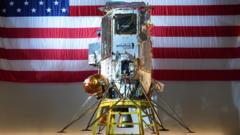The emergence of lunar and orbiting data centers is being driven by the escalating demand for data storage, alongside the constraints of ground-based facilities. Companies like Lonestar and Starcloud aim to capitalize on these extraterrestrial opportunities, albeit amid significant engineering and logistical challenges.
**A New Frontier for Data Centers: The Moon and Beyond**

**A New Frontier for Data Centers: The Moon and Beyond**
Exploring the prospect of off-world data centers that promise increased security and efficiency.
In a futuristic turn of events, Lonestar Data Holdings is paving the way for data centers beyond Earth, with ambitions of establishing operations on the Moon. The company's president, Stephen Eisele, envisions a secure and energy-efficient data processing hub shielded from terrestrial drawbacks. This follows the successful testing of a miniature data center that was sent to the Moon aboard Intuitive Machines’ Athena Lunar Lander, underscoring a bold new frontier in data management.
Data centers, essentially massive warehouses of computers managing data for various entities, are facing significant challenges on Earth. The demand for data storage and processing has soared, particularly due to the growth of artificial intelligence, with projections indicating an annual increase of 19% to 22% by 2030 (according to McKinsey). This uptick in demand conflicts with the decreasing availability of land and increasing opposition from local communities regarding new data center developments due to their substantial power and water consumption.
Eisele believes that relocating data centers to space could mitigate these issues. With unlimited solar energy and no neighboring communities, the Moon presents an ideal environment for data processing, especially for tasks associated with spacecraft. Echoing these sentiments, a study funded by the European Commission has highlighted the viability and environmental advantages of orbiting data centers, suggesting they could revolutionize digital landscapes in Europe.
Thales Alenia Space has proposed a network of satellites capable of creating a space-based data center infrastructure, showcasing the growing commitment to this venture. However, achieving a sustainable model relies on minimizing emissions from rocket launches and the ability to deploy large-scale systems in orbit.
Despite the ambitions of companies like Lonestar, barriers remain. The financial implications of space launches—costing thousands of dollars per kilogram—present a significant hurdle. Additionally, cooling systems, vital in maintaining data center efficiency, may face complications in a zero-gravity environment. Space debris and weather would further jeopardize the operational stability of these facilities.
The proposed timeline indicates that the first operational data centers could emerge by 2027, with competing firms like Starcloud accelerating their initiatives. According to Eisele, the distances involved can provide extra security for sensitive data, potentially shielding it from cyber threats through enhanced physical separation from existing terrestrial networks.
With various governments, including Florida and the Isle of Man, showing interest, the future of data centers may very well lie among the stars—a development highlighting both the potential and complexity of expanding our digital infrastructure beyond our planet. As this ambition unfolds, it raises essential questions about sustainability, governance, and technological reliability in the uncharted territories of space.
Data centers, essentially massive warehouses of computers managing data for various entities, are facing significant challenges on Earth. The demand for data storage and processing has soared, particularly due to the growth of artificial intelligence, with projections indicating an annual increase of 19% to 22% by 2030 (according to McKinsey). This uptick in demand conflicts with the decreasing availability of land and increasing opposition from local communities regarding new data center developments due to their substantial power and water consumption.
Eisele believes that relocating data centers to space could mitigate these issues. With unlimited solar energy and no neighboring communities, the Moon presents an ideal environment for data processing, especially for tasks associated with spacecraft. Echoing these sentiments, a study funded by the European Commission has highlighted the viability and environmental advantages of orbiting data centers, suggesting they could revolutionize digital landscapes in Europe.
Thales Alenia Space has proposed a network of satellites capable of creating a space-based data center infrastructure, showcasing the growing commitment to this venture. However, achieving a sustainable model relies on minimizing emissions from rocket launches and the ability to deploy large-scale systems in orbit.
Despite the ambitions of companies like Lonestar, barriers remain. The financial implications of space launches—costing thousands of dollars per kilogram—present a significant hurdle. Additionally, cooling systems, vital in maintaining data center efficiency, may face complications in a zero-gravity environment. Space debris and weather would further jeopardize the operational stability of these facilities.
The proposed timeline indicates that the first operational data centers could emerge by 2027, with competing firms like Starcloud accelerating their initiatives. According to Eisele, the distances involved can provide extra security for sensitive data, potentially shielding it from cyber threats through enhanced physical separation from existing terrestrial networks.
With various governments, including Florida and the Isle of Man, showing interest, the future of data centers may very well lie among the stars—a development highlighting both the potential and complexity of expanding our digital infrastructure beyond our planet. As this ambition unfolds, it raises essential questions about sustainability, governance, and technological reliability in the uncharted territories of space.





















